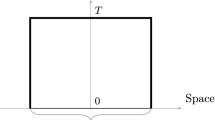Abstract
We consider the transition probabilities for random walks in \(1+1\) dimensional space-time random environments (RWRE). For critically tuned weak disorder we prove a sharp large deviation result: after appropriate rescaling, the transition probabilities for the RWRE evaluated in the large deviation regime, converge to the solution to the stochastic heat equation (SHE) with multiplicative noise (the logarithm of which is the KPZ equation). We apply this to the exactly solvable Beta RWRE and additionally present a formal derivation of the convergence of certain moment formulas for that model to those for the SHE.

Similar content being viewed by others
References
Alberts, T., Khanin, K., Quastel, J.: The intermediate disorder regime for directed polymers in dimension \(1+1\). Ann. Probab. 42, 1212–1256 (2014)
Amir, G., Corwin, I., Quastel, J.: Probability distribution of the free energy of the continuum directed random polymer in \(1+1\) dimensions. Commun. Pure Appl. Math. 64, 466–537 (2011)
Balázs, M., Rassoul-Agha, F., Seppäläinen, T.: The random average process and random walk in a space-time random environment in one dimension. Commun. Math. Phys. 266, 499–545 (2006)
Barraquand, G., Corwin, I.: Random-walk in beta-distributed random environment. Probab. Theory Relat. Fields (2016). doi:10.1007/s00440-016-0699-z
Borodin, A., Corwin, I.: Macdonald processes. Probab. Theory Relat. Fields 158, 225–400 (2014)
Caravenna, F., Sun, R., Zygouras, N.: Polynomial chaos and scaling limits of disordered systems. J. Eur. Math. Soc. (to appear)
Corwin, I.: The Kardar-Parisi-Zhang equation and universality class. Random Matrices Theory Appl. 1, 1130001 (2012)
Corwin, I.: Macdonald processes, quantum integrable systems and the Kardar-Parisi-Zhang universality class. In: Proceedings of the International Congress of Mathematicians. (2014)
Rassoul-Agha, F., Seppäläinen, T., Yilmaz, A.: Quenched free energy and large deviations for random walks in random potentials. Commun. Pure Appl. Math. 66, 202–244 (2013)
Thiery, T., Le Doussal, P.: Exact solution for a random walk in a time-dependent 1D random environment: the point-to-point Beta polymer. (2016). arXiv:1605.07538
Acknowledgements
I.C. was partially supported by the NSF through DMS-1208998, the Clay Mathematics Institute through a Clay Research Fellowship, the Institute Henri Poincaré through the Poincaré Chair, and the Packard Foundation through a Packard Fellowship for Science and Engineering. Y.G. was partially supported by the NSF through DMS-1613301.
Author information
Authors and Affiliations
Corresponding author
Appendix 1: Sharp Large Deviation for Symmetric Simple Random Walk
Appendix 1: Sharp Large Deviation for Symmetric Simple Random Walk
Recall that
\(p_{\sigma ^2}(t,x)\) is the density of \(N(0,\sigma ^2t)\), and assume that \(m_1,m_2\in \mathbb {Z}\), \(|m_1|,|m_2|\leqslant 1\) and \(m_1-m_2\) is even.
Lemma 4.1
For fixed \(t>0,x\in \mathbb {R}\), we have
as \(\varepsilon \rightarrow 0\), and there exists a constant \(C>0\) such that for all \(t>0,x\in \mathbb {R}\),
Proof
To simplify the notation, let
so that \(\mathscr {P}_\varepsilon (t_\varepsilon ,x_\varepsilon ,m_1,m_2)=\mathbf {P}^{0}(S_n=m)\). We will utilize the notation \(\lesssim \) when the left-hand side is bounded by a constant (independent of \(\varepsilon \) and t and x) times the right-hand side for all \(\varepsilon \) sufficiently small. We first prove the estimate (4.2) that is uniform in \(t>0,x\in \mathbb {R}\), then prove the convergence in (4.1) for fixed \(t>0,x\in \mathbb {R}\).
Case 1 \(t\leqslant 100\varepsilon ^2\). It is clear that \(t_\varepsilon \leqslant 100\varepsilon ^2\), and by the fact that \(|m|\leqslant n\) (or else \(\mathbf {P}^{0}(S_n=m)=0\)), there exists \(C>0\) so that \(|x_\varepsilon |\leqslant C\varepsilon \). Thus, we have
This proves the first bound on the right-hand side of (4.2).
Case 2 \(t>100\varepsilon ^2\). Recall that \(|m_1|,|m_2|\leqslant 1\), so \(n\geqslant 90\)—we will implicitly use the largeness of n in some of the bounds below. By (4.3),
which implies
Using Stirling’s approximation,
we derive the bound
when \(|m|<n\).
Now we consider three different subcases of case 2. Fix \(0<\tau \ll 1\), and let \(k=m/n\).
Case 2.i \(|k|=1\). We have \(P(S_n=m)=2^{-n}\), so
In both cases of \(m=n\) and \(m=-n\), using the fact that \(v\in (0,1)\), we have
for some \(\delta >0\) depending on v. Furthermore,
so it remains to show that \(x^2/t\lesssim n\). By the fact that \(|m|\leqslant n\), we have
which implies \(-t\lesssim \varepsilon x\lesssim t\). This implies that in this case, the second bound on the right-hand side of (4.2) holds.
Case 2.ii \(|k|<1\) and \(|k-v|\geqslant \tau \). We have
where
It is straightforward to check that F(k) attains its minimum at v and \(F''(k)\) is bounded from below by some positive constant. Since \(|k-v|\geqslant \tau \), we have \(F(k)\geqslant \delta \tau ^2\) with \(\delta =\frac{1}{2}\min _{k\in (-1,1)} F''(k)\). In addition, since \(|m|<n\), we have \(-n+2\leqslant m\leqslant n-2\), so
Therefore, we have
and the same discussion as in case 2.i shows \(e^{-\frac{n}{4}\delta \tau ^2}\lesssim e^{-\frac{x^2}{Ct}}\) for some \(C>0\), matching the second bound on the right-hand side of (4.2).
Case 2.iii \(|k-v|<\tau \). We have
For the exponent, it is clear that \(F(k)\geqslant \delta (k-v)^2\) with the same \(\delta >0\) from case 2.ii, so
Since \(k=m/n\) with m, n given in (4.3), we have
so
for some \(C,\tilde{C}>0\). For \(M>0\), if \(|x|\leqslant M\varepsilon \), we have the desired estimate; if \(|x|>M\varepsilon \), we have
so we only need to choose M sufficiently large to complete the proof of (4.2).
To prove (4.1), we note that for fixed \(t>0,x\in \mathbb {R}\) and sufficiently small \(\varepsilon \), \(|k-v|\ll 1\) (we are in the region of case 2.iii). We use Stirling’s approximation and the fact that \(n,\frac{n+m}{2},\frac{n-m}{2}\rightarrow \infty \) to obtain that
as \(\varepsilon \rightarrow 0\). Thus we only need to analyze
with F(k) defined in (4.5). First, we have
Secondly, by (4.6), we have \(|k-v|\lesssim \varepsilon \) for fixed \(t>0,x\in \mathbb {R}\) and \(n(k-v)^2\rightarrow \frac{x^2}{t}\) as \(\varepsilon \rightarrow 0\). We expand \(F(k)=\frac{1}{2}F''(v)(k-v)^2+O(|k-v|^3)\) and conclude that
as \(\varepsilon \rightarrow 0\). This completes the proof of (4.1). \(\square \)
Rights and permissions
About this article
Cite this article
Corwin, I., Gu, Y. Kardar–Parisi–Zhang Equation and Large Deviations for Random Walks in Weak Random Environments. J Stat Phys 166, 150–168 (2017). https://doi.org/10.1007/s10955-016-1693-7
Received:
Accepted:
Published:
Issue Date:
DOI: https://doi.org/10.1007/s10955-016-1693-7



